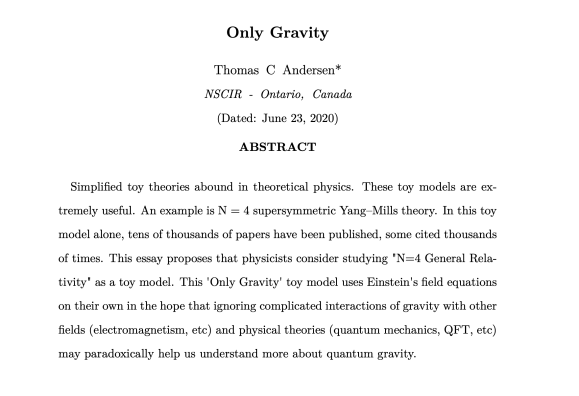I don’t divulge the recipe until later, lets start with the most undark matter we can find – CERNs protons.
CERN has proton – antiproton collisions going on at 7 TeV. There are collisions that generate up to a few TeV of photons.
Lets look at that from a viewpoint of classical physics, with some General Relativity added in the right place.
We have a few TeV of photons, these are generated in an extremely short period of time. We have two protons approaching and hitting (basically head on to get 2TeV of gammas). They are travelling at c. So that’s an interaction time of 2fm/3e8 m/s – 1.5 e-24 seconds.
So what happens gravitationally?
I have recently read a paper Monopole gravitational waves from relativistic fireballs driving gamma-ray bursts by Kutshera (http://arxiv.org/abs/astro-ph/0309448) that talks about this effect for, well exploding stars.
We have in a small area a mass of 7 TeV, of which about half leaves via gammas, the rest is in ‘slower’ particles like those higgs bosons, etc. This drop in mass results in a monopole gravitational wave. How big:
The force of Gravity is usually determined by the masses of the objects involved. But gravity is a local phenomenon (Einstein’s vision, not Newtons), and the field is actually a gradient of the potential.
So we have a potential change from 7 TeV to 5 TeV as seen by an observer near the collision as 2 TeV of gammas go whizzing by in a time span of 10-24 secs. Lets take the observer to be just outside the interaction area, say 10 fm away.
The gradient of the potential changes as the mass changes, which means its time dependent. We need the gradient.
Look at the Gravitational potential of the observer before and after the wave passes.
Before G(7 TeV)/10fm and after we have G(5 TeV)/10fm. So that’s an potential difference of G(2TeV)/10fm acting over a time of 1e-24 seconds, which means that we have a gradient of (some math. )SI units! Observer is a proton 10fm away,
I get 8.1×10-20 Watts – i.e. the observer proton sees its energy rise at a rate of 10-19 watts for 1e-24 seconds, it gets a boost in the away from the interaction, which raises its energy by a mere 5e-25eV.
Not much. But what I think is missing is that this sort of effect has to be looked at on a much smaller scale, and repeating, in that this monopole gravitational energy is coming in – then bouncing back out. The proton is thus an engine to this coherently at 1e40Hz or more, which makes other protons/electrons feel a force (they are bouncing this gravitational monopole radiation back and forth too) of the same size as the coulomb force. So this is the coloumb force. Electromagnetism as a phenomena of General Relativity. If you re-do the math with 10-47 or so seconds as the period then you start to see coulomb level forces at play. (Taking away accelerator energies ‘only’ adds a few zeros to the huge frequency requirement for mass exchange.)
The coloumb force rides above this – its a meta field ontop of this gravitationally built monopole system.
I think that electrons do this in a native, compact manner, likely using topology, while protons employ a complicated-ish ‘engine’ built of springs and struts made of GR that produce the same force as an electron. The strength of this force is determined by a feedback mechanism to balance that of the electrons.
Could dark matter be unlit(inactive/relaxed) protons? In other words protons that are not near an electron, and thus stop vibrating and being a charged particle. No near electron means no feedback means no charge. So perhaps looking for dark matter using a dense matter system like a block of germanium is bound to fail. We need to look using some sort of empty space experiment that gets to the vacuum conditions of interstellar (as we know dark matter exist on an interstellar scale).
An experiment might be to create a very hard vacuum starting with a hydrogen plasma, then as you pump down, look for some sort of indication that the charge of the remaining protons and electrons in the gas has gone down. You might look at the response of the p/e left in the chamber to photons – there will be less scattering as you pump down, but if the scattering falls off a cliff faster than your pumping rate you have made dark matter.
What is the distance at which this effect might happen at? In other words how far apart do electrons and protons have to be before the charge effect starts to stall? I am not talking about the range of photons – that’s infinite, but about the range of this effect – where will protons start to lose the signal from electrons, and calm down? 1m, 1micron? What is the density of gas in quiet parts of the galaxy? Intergalactic space is 1 atom/m3, I would say 1e6x this level is likely for some wastelands in the milky way. (we need dark matter in the milky way to get our velocity curves right!) So that’s 1 per cm3.
What’s the best vacuum you can make?
Ultra-high vacuum chambers, common in chemistry, physics, and engineering, operate below one trillionth (10−12) of atmospheric pressure (100 nPa), and can reach around 100 particles/cm3
That’s about the right density. So has anyone ever measured laser scattering in such a chamber as a function of pressure? Corrected for pressure, we would get a horizontal line in a suitable graph. Boring stuff, it would seem, so likely not measured. The mean free path is 40km in these chambers.
Some problems solved by this ‘dark matter is matter gone dark’ hypothesis:
1) Early universe. It has been determined that the early universe must have had a mass that was much larger than the observed mass today. This is solved with dark matter, but that dark matter would have had to take part in things. If it were instead all just regular matter, there is no problem.
2) Early universe clumpiness: Its been really hard to come up with galaxies born so quickly. Yet they can be seen with telescopes. With all the matter in the early universe taking part, clumps are easier to make.
3) The lack of dark matter peaks at galactic cores. This one stumps the experts – physicists were sure that dark matter would accumulate at galactic cores, but it does not. If you have matter lighting up as it moves close to the core, then the radiation given off by this newly lit matter would keep things expanded, furthermore it is seen at the core, and so does not count as being dark. (http://www.cfa.harvard.edu/news/2011-29)
Early universe CMB
This is the way things are thought to work.
If all the matter was lit, then the He4/Li levels would be not what is observed. ==> Some kind of non interacting matter was needed.
The CMB is too smooth. Dark matter is needed to make galaxies:
Dark matter condenses at early epoch and forms potential wells, the baryonic matter flows into these wells and forms galaxies (White & Rees 1978). (Ref: http://ned.ipac.caltech.edu/level5/Sept09/Einasto/Einasto4.html)




 Andersen, T. C. on ORCID
Andersen, T. C. on ORCID



